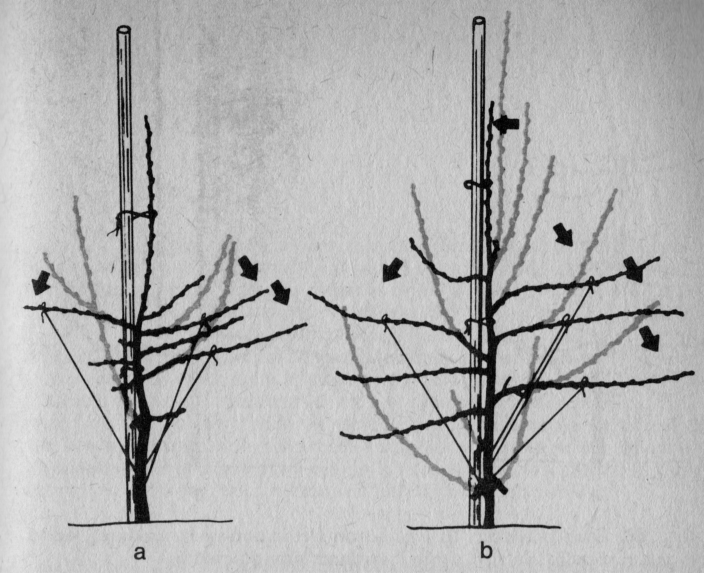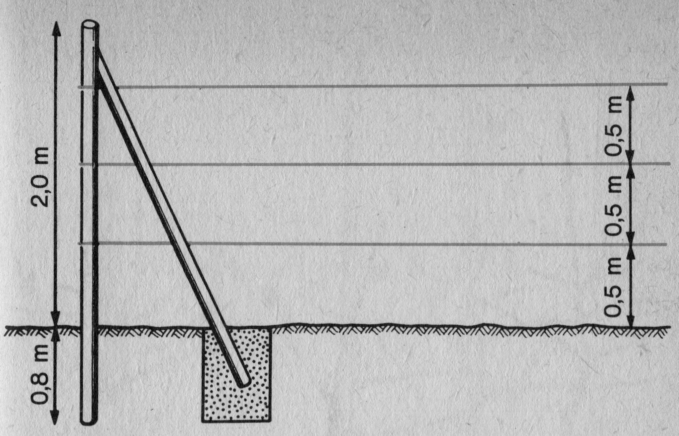one day. The stakes should be immersed in the preparation at least up to the height 80 Cm.
Permanent scaffolding for dwarf trees are reinforced concrete posts with horizontal wires spread over them (characteristic. 85).
Characteristic. 85. Durable scaffolding to tie down dwarf trees
The posts should be long 2,8 m, cross-section 8X8 or 10X10 cm. The posts are placed in rows of co 20-25 m and spreads on them galvanized wires in diameter 2-3 mm. For spindle molds, it is enough to unfasten two wires in height 0,5 and 2 m from the ground. Vertical slats or edgings made of boards are attached to each tree between the wires, used to tie a guide. If dwarf trees, are run in a liner form, the wires are unbuttoned what 0,5 m. On 1 ha need from 100 into 120 bars.
The pruning of trees in the first year after planting is similar to the formation of almost natural crowns. Unbranched specimens are pruned to a height of 40-50 cm and the conductor is shortened. Side shoots are shortened by 1/3-1/2 only in these cases, when trees cannot be provided with enough water (characteristic. 84).

Characteristic. 84. Pruning of dwarf apple and pear trees in the first year of formation of the spindle crown: a - shorten unbranched buds at a height of 60-80 cm from the ground; b - prune branched limbs low to the ground to a height of 40-50 cm; c - slightly shorten their conductor and stronger side shoots.
Trees grafted on stunted inserts require a little more attention. Many of them have only 1-2 strong side shoots, which are not suitable for limbs, because they're too stiff to bend. Such shoots have to be cut out and wait until next year for new growths (characteristic. 86).

Characteristic. 86. Cutting grafted apple trees on stunted inserts: a - a branched apple tree in the shape of a Christmas tree does not require pruning; b, c - remove side shoots in fork-branched apple trees.
After pruning trees in March or April, you should put clips on the guide in May, for wide bifurcation angles.
In the second year after planting, bend all flexible shoots to a horizontal position and tie them in this position with strings to a stake or to a wire stretched in a row. (characteristic. 87a). Some trees will have 1-2 shoots that are too stiff and difficult to bend, which need to be cut. The guide is tied vertically at the stake. The best length is 40-60 cm, because such one does not need to be shortened and then new branches growing on it have wide angles of bifurcation by nature. If the guide is long, it can be cut and the first side shoot from the top tied vertically to the stake. Vertically guided lateral momentum will continue to act as a guide (characteristic. 87b).

Characteristic. 87. Forming a spindle crown in the second year: a - bend flexible shoots to the level, Remove stiff shoots; b - a too strong conductor is replaced with a weaker side shoot, Remove shoots grown close to the ground.
In the third and fourth years, we continue bending the shoots leading the guide to the height 2 m, During this period, attention should be paid to the symmetrical development of the tree crown. Branches can be found on some trees, which are not bent enough at the base, they grow too strongly becoming competitors for the guide. Such limbs must be cut smooth or shortened very much over the growth directed downwards (characteristic. 88a, b).
The formation of spindle crowns is as time-consuming as the formation of lined crowns.

After forming, we apply an annual spring cut to regulate the shape of the crowns and the density of the branches. From the bottom, we cut the branches up to the height 50 Cm. Branches crossing, overlapping, or damaged ones are cut smoothly. In the upper parts of the crown, cut out the strongest shoots, so that this part of the crown does not grow excessively. The conical shape of the crowns should be maintained throughout the growing period of trees (characteristic. 89).
If the trees are growing strong enough, what can happen when growing apple trees grafted on the M rootstock 26, then you have to shorten the branches going into the inter-rows. Thanks to the cutting, we change the shape of the crowns from circular to oval, forming a half-palette. Such cutting enables free passage between the rows while maintaining all branches growing in the row line.
